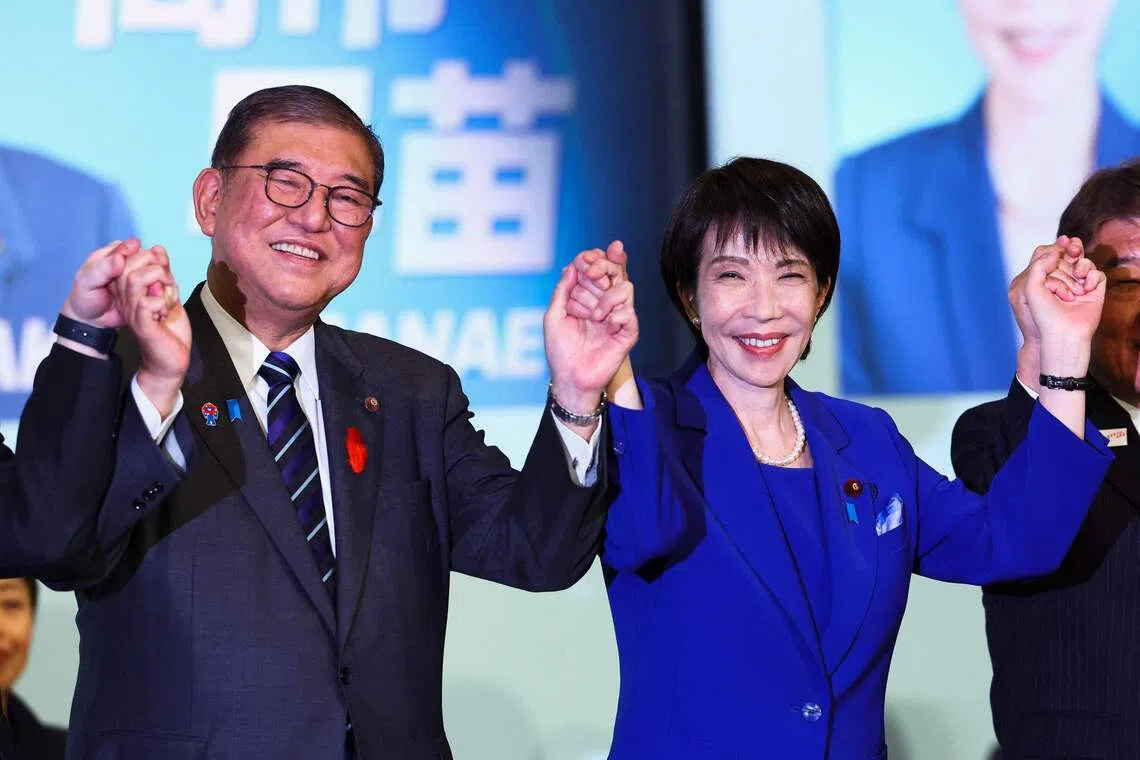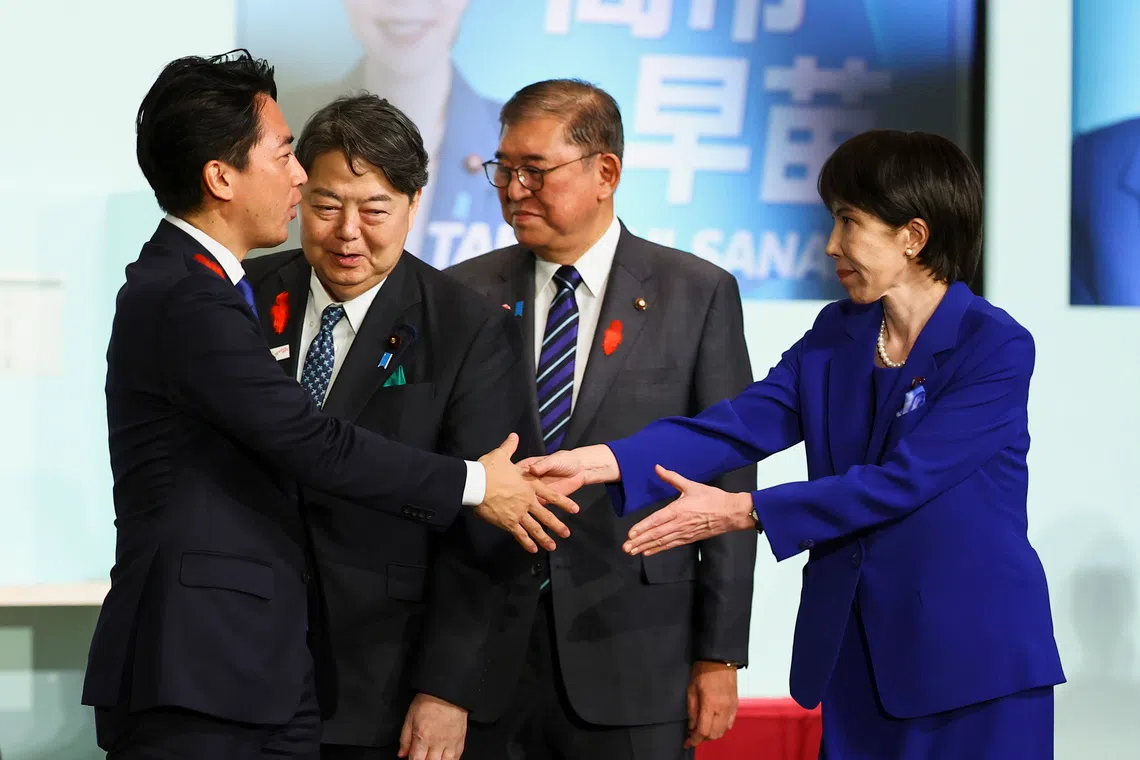Sanae Takaichi set to be Japan’s first woman prime minister after winning ruling LDP’s election
Sign up now: Get insights on Asia's fast-moving developments

Ms Sanae Takaichi, the newly elected leader of Japan's Liberal Democratic Party, celebrating her election win with Prime Minister Shigeru Ishiba in Tokyo on Oct 4.
PHOTO: AFP
Follow topic:
TOKYO – Japan is set to get its first woman prime minister after former economic security minister Sanae Takaichi, 64, prevailed in a five-horse race to succeed Mr Shigeru Ishiba.
Ms Takaichi, the conservative protege of the late former premier Shinzo Abe, is almost a shoo-in to take the top position when the Diet convenes for an extraordinary session, expected on Oct 15.
While the ruling Liberal Democratic Party (LDP) and its coalition partner Komeito do not have a parliamentary majority, the next prime minister is odds-on to be from the LDP, given that a fragmented opposition means the parties are unable to unify to elevate one of their own.
Also on Oct 15, Mr Ishiba’s Cabinet will resign en masse, putting an end to a short-lived tenure that, despite its woes, would have lasted longer than that of LDP heavyweights such as Mr Taro Aso (2008-2009).
Ms Takaichi’s first diplomatic test as prime minister is expected to be a meeting with US President Donald Trump, who is due to visit Tokyo later in October.
She has criticised Tokyo’s tariff deal with Washington – under which Japan promises to invest US$550 billion (S$709 billion) in the US
“There are many diplomatic issues, but I will work to strengthen the Japan-US alliance as the basis for trilateral cooperation with countries like South Korea, Australia and the Philippines,” she said.
“I am also determined for Japan to play a more active role in leading a free and open Indo-Pacific, and contribute to global peace by taking on and overcoming common challenges.”
There is a risk, however, that her win could pull Japanese politics sharply to the right.
During the hustings, she made borderline xenophobic claims
Analysts fear she might be tempted to capitalise on the prevailing nationalist anti-foreigner mood that has manifested in the rise of far-right opposition parties.
Doshisha University’s political scientist Toru Yoshida told The Straits Times: “Takaichi is very good at posturing – she will stick to her guns on economic or social issues, but she will not take a wrecking ball approach to diplomacy.”
And while it is historically significant that Ms Takaichi will likely be the first female prime minister, he noted: “Just because she’s a woman doesn’t necessarily mean that she will promote gender-based or feminist policies.”
She opposes the right for married couples to have different surnames, saying that this would destroy the fabric of a family. In what is a rarity for Japan, where women usually take the male surname upon marriage, her husband adopted her family name.
Meanwhile, investors are concerned with her pledges to boost spending to stimulate growth, and her preference for distributive economic policies. She had also previously been critical of the Bank of Japan’s efforts to raise interest rates, and on Oct 4 repeated her pessimism over the health of the Japanese economy.
In the region, there would continue to be concerns that Ms Takaichi, whose past views of Japan’s wartime history have antagonised both China and South Korea, would push beliefs that could upset the geopolitical balance.
China’s Foreign Ministry said in a statement to Kyodo News on Oct 4 that Beijing expects Tokyo to “pursue a positive and rational policy” towards China on the basis of its existing political documents.
Taiwan’s President Lai Ching-te, meanwhile, extended his “warmest congratulations” to a “steadfast friend”, as he expressed hopes for closer exchanges and cooperation, while ensuring regional security.
Ms Takaichi, coming up tops on her third run for the country’s top job after failed bids in 2021 and 2024, said in her victory speech that she would abandon the idea of “work-life balance” given her list of priorities.
She said: “Rather than feeling happy right now, I believe the future is truly challenging. We need to turn the anxieties of many people into hope.”
This prompted light-hearted chiding from Mr Ishiba, to laughs from the audience of lawmakers, as he said in his congratulatory speech: “I wonder if it is okay to so explicitly state that we will abandon the idea of work-life balance. But I believe this shows the determination by Ms Takaichi to devote her whole being and soul to the good of this nation.”
He added: “Many countries are struggling with conflict and division, and our country must do everything we can to be a role model in overcoming this. We must also move towards a high value-added economy.”
Ms Takaichi won against Agriculture Minister Shinjiro Koizumi, 44, in a run-off vote after the first round failed to produce a conclusive winner.

Japan’s former economic security minister Sanae Takaichi shaking hands with Agriculture Minister Shinjiro Koizumi after the Liberal Democratic Party leadership election on Oct 4.
PHOTO: EPA
Dr Mikitaka Masuyama of the National Graduate Institute for Policy Studies believed that Ms Takaichi’s dominance among rank-and-file members – where she scored 40 per cent of the vote and was the top choice in 31 out of 47 prefectures – was the deciding factor for lawmakers going into the second round.
“It’s not so different from the shift towards conservative populism that is apparent in Japan now,” he said.
He observed that many rank-and-file members in the LDP believe the party has lost its identity after it started to drift under the successive administrations of Mr Yoshihide Suga (2020-2021), Mr Fumio Kishida (2021-2024) and then Mr Ishiba.
Of the 342 votes at stake in the run-off poll, Ms Takaichi won 185 and Mr Koizumi took 156. There was one invalid vote.
“Why did I run in this presidential election? It’s because of a strong sense of crisis that the LDP must change for the sake of Japan’s present and future.
“I want to create a politics that turns anxiety about current living conditions and the future into hope,” Ms Takaichi said in her final appeal before the run-off vote.
She noted the harsh criticism from across the country, that it “has become difficult to understand what the LDP wants to achieve” amid questions over whether the party truly understands the hardships of everyday life.
The other candidates in what had been a five-horse race were Chief Cabinet Secretary Yoshimasa Hayashi, 64; former economic security minister Takayuki Kobayashi, 50; and former foreign minister Toshimitsu Motegi, 69.
The contest on Oct 4 was triggered by Mr Ishiba’s announcement on Sept 7 that he would step aside
Mr Ishiba, who took office on Oct 1, 2024, had been facing a coup from rivals baying for blood after electoral drubbings left the ruling coalition without a majority in both chambers of Parliament.
Ms Takaichi will see out the remaining two years of Mr Ishiba’s three-year tenure as LDP president, with the next party leadership race to be held in 2027.
The LDP has dominated Japanese politics for most of the postwar era since its founding in 1955; it has always been part of the ruling government, except for brief periods from 1993 to 1994 and from 2009 to 2012.
The Oct 4 party election, however, comes as the LDP has lost its grip on voters who had become disillusioned with the party. The 910,000 rank-and-file members today are but a fraction of the numbers during its heyday, when it had more than five million card-carrying members.
The LDP’s electoral defeats come on the heels of successive scandals over the use of party funds, as voters suffer from rising costs of living.
Adding to these pressures are perceived challenges associated with a wave of foreign arrivals, mainly tourists, that have been seized on by populist parties and far-right challengers, who have chipped away at the LDP’s traditional support.
The key challenge for the LDP under its new leader, Sophia University political scientist Koichi Nakano told ST, is to show that the party is willing to listen to voter concerns and rebrand itself.
“The way in which the LDP presidential race unfolded has been very inward-looking, with candidates repeating meaningless pledges to rebrand the party without elaborating on the ‘how’,” he said.
“They are aware that the LDP needs to rebrand itself, but they also know that they cannot antagonise any part of the party because they are shrinking and tensions are high internally.”
Ms Takaichi is expected to fill LDP party positions within days, with horse-trading with the opposition set to intensify in the run-up to the Diet session.
Notwithstanding the party’s status as a minority government, the next LDP leader will preside over a period of relative political stability, as no national election is due until 2028.


